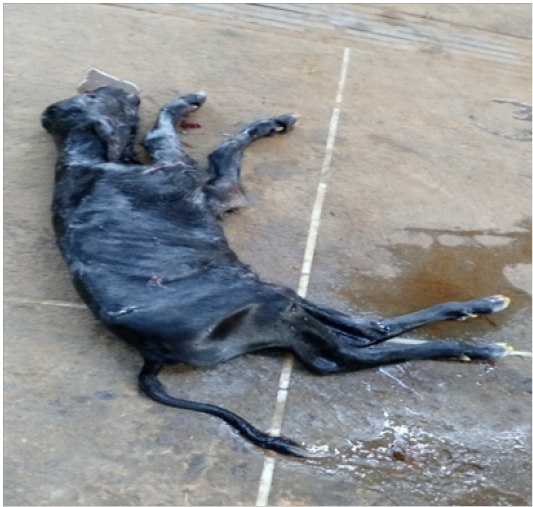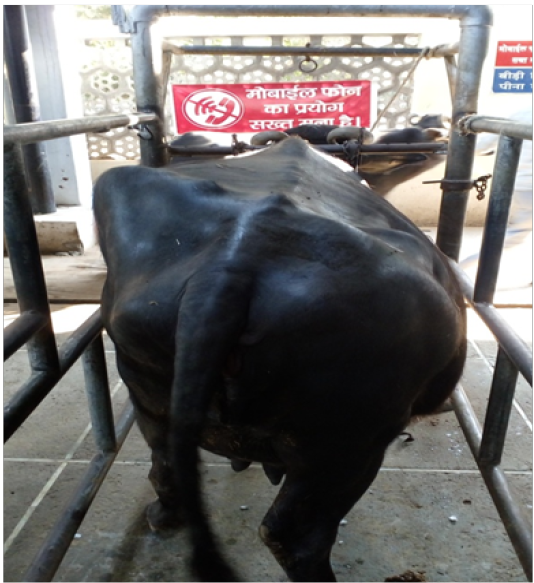Research Journal for Veterinary Practitioners
Case Report
Successful Management of a Rare Case of Dystocia Due to Narrow Pelvis Associated with Pelvic Fracture in Water Buffalo
Ravi Dutt1*, Gyan Singh2, Subhash Chand Gahalot3, Karan Sharma4, Vinay Yadav5, Shivanagouda Shasidhar Patil6
1*,3,4,5,6Department of Veterinary Gynaecology & Obstetrics; 2Department of Veterinary Clinical Complex, College of Veterinary Sciences, Lala Lajpat Rai University of Veterinary and Animal Sciences, Hisar-125004, India.
Abstract | The present case report communicates the successful management of a rare case of dystocia due to narrow pelvis in a pluriparous water buffalo, encountered pelvic fracture four days after last parturition. A dead fetus was delivered per vaginally through mutation.
Keywords | Water buffalo, Dystocia, Narrow pelvis, Pelvic fracture, Mutation
Editor | Muhammad Abubakar, National Veterinary Laboratories, Islamabad, Pakistan.
Received | June 27, 2017; Accepted | September 12, 2017; Published | September 24, 2017
*Correspondence | Ravi Dutt, Department of Veterinary Gynaecology & Obstetrics, College of Veterinary Sciences Lala Lajpat Rai University of Veterinary and Animal Sciences, Hisar-125004, India. Email: raviduttvets@yahoo.co.in
Citation | Dutt R, Singh G, Gahalot SC, Sharma K, Yadav V, Patil SS (2017). Successful management of a rare case of dystocia due to narrow pelvis associated with pelvic fracture in water buffalo. Res. J. Vet. Pract. 5(3): 34-36.
DOI | http://dx.doi.org/10.7582/journal.rjvp/2017/5.3.34.36
ISSN (Online) | 2308-2798
Copyright © 2017 Dutt et al. This is an open access article distributed under the Creative Commons Attribution License, which permits unrestricted use, distribution, and reproduction in any medium, provided the original work is properly cited.
Pelvic abnormalities of the dam that can result in dystocia include small size of the pelvis (Purohit et al., 2012), pelvic deformities, exostoses, osteomalacia and hypoplasia of the vagina and vulva (Kodagali, 2003). Narrow pelvis is a common maternal cause of dystocia in the buffalo (Singh et al., 1978). The incidence of narrow pelvis in cattle and buffalo is known to be 7.79% (Phogat et al., 1992) to 9.2% (Sharma et al., 1992). Pelvic fracture is one of the main causes of narrow pelvic canal (Dubay, 1987). In animals with narrow pelvis, parturition may not proceed over first stage, as the chances of fetus being stuck in the pelvic inlet are more. Surgical intervention is the only way for delivering the fetus in such cases, as forced traction may endanger the life of both dam and offspring (Samantha, 2011). The present case report communicates dystocia due to narrowed pelvis in a water buffalo and its per-vaginal delivery of a dead fetus by obstetrical mutation.
A pluriparous full term pregnant Murrah buffalo was referred to the Veterinary Clinical Complex, LUVAS, Hisar with the history of active labour for the past four hours followed by cessation of straining thereafter. The Animal also had a history of an accidental injury on hindquarters due to sudden falling four days after last parturition and showing drooping of right hip bone (Figure 1). Following the injury the animal was treated with Ayurvedic medicines and survived well in successive gestation period without exhibiting any sign of lameness. It was difficult to figure out relaxation of pelvic ligaments. Both the water bags had already been ruptured. Per-vaginal examination revealed presence of both forelimbs and head in birth canal. The dead fetus was in anterior presentation, dorso-sacral position and the head was posterior to the cervix.
The obstetrical management was commenced under posterior epidural anaesthesia with 2% lignocaine hydrochloride. After proper lubrication of birth canal with liquid paraffin both the forelimbs were repelled back in the uterus to create space for facilitating easy extraction of head. A long obstetrical eye hook was fixed in the medial canthus of both the eye orbits. By help of mild traction head was brought in the birth canal. Then, both forelimbs were brought into birth canal manually by hand. Both fore limbs were secured with obstetrical chains at the fetlock joint. By means of gentle traction the dead fetus (Figure 2) was delivered. Post-obstetrically the dam was administered with Calcium-Magnesium-Boro-gluconate 450 ml slow i.v., 50 IU of Oxytocin in1 liter normal saline i.v., Cefoperazone plus Sulbactam 4.5 gm i.m., Meloxicam 100 mg i.m., rumenotorics (Inj. Rumeric, Virbac India, 10 ml im). Antibiotics, anti-inflammatory and rumenotorics were also advised for further 5 days. The fetal membranes expelled 6 hours after the delivery of fetus and the dam recovered uneventfully.

Figure 2: Dead fetus delivered through mutation
In general, maternal dystocia is rare in buffaloes because of capacious pelvis. But, narrowing of pelvis may occur due to accidents causing pelvic fracture (Sharma et al., 1992) or pathological causes like tumours (Sharma et al., 1977). In the present case, dystocia was due to narrowed pelvis resultant of falling on the ground. The shaft of ilium got fractured and its sharp edged fragments were projected inwardly into pelvic cavity and healed by malunion which led to obstruction of birth canal. Though the calf was in normal presentation and position, narrow pelvis forced the head of fetus to lateral side made eutokia impossible. Similar cases were also reported previously in buffalo (Kamalakar et al., 2016) and cattle (Kaliraja et al., 2017) and caesarean section is universally opted for such complicated dystocias (Purohit et al., 2013). If the birth canal is too narrow, it is advised to opt for caesarean section (Purohit et al., 2011). But before opting for caesarean section, vaginal examination is mandatory to judge the birth passage. In case space is optimum for obstetrical mutation, gentle traction maybe applied on the fetus after plenty of lubrication, as employed in the present case.
Acknowledgements
Authors are highly thankful to Head Department of Veterinary Clincical Complex, LUVAS for providing the required facilities.
Conflict of Interests
There is no conflict of interest to declare.
Author’s Contribution
All authors contributed equally.
References






